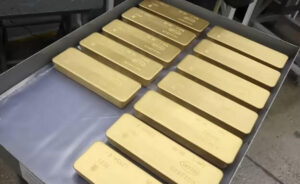The Safest Ways to Invest in Gold and Silver

In today’s uncertain economic climate, the allure of precious metals like gold and silver as safe-haven investments has never been stronger. With volatility in traditional financial markets and concerns about inflation, many investors are seeking to learn how to invest in gold to protect their wealth.
In this article, we’ll explore the safest ways to invest in gold and silver, including the option of gold IRAs.
The Timeless Allure of Gold and Silver
For millennia, gold and silver have held a special place in the hearts of investors and collectors alike. These precious metals offer unique characteristics that make them attractive, particularly during uncertain times:
- Inherent Value: Gold and silver have intrinsic value because they are tangible assets with limited supply. Unlike fiat currencies, their worth is not dependent on government policies or central bank decisions.
- Diversification: Precious metals can be a valuable addition to a diversified investment portfolio. They often exhibit low correlation with other asset classes, such as stocks and bonds, making them an effective hedge against market volatility.
- Historical Performance: Throughout history, gold and silver have proven their ability to retain value and even appreciate over time. They have withstood economic crises, wars, and political turmoil.
Given these compelling advantages, let’s explore the safest ways to invest in gold and silver, so you can make informed decisions about safeguarding your wealth.
Investing in Physical Gold and Silver
One of the most direct ways to invest in gold and silver is by purchasing physical bullion. This method allows you to own the actual metals, providing you with tangible assets that you can hold in your hands. Here’s how to go about it:
- Gold and Silver Coins: Precious metal coins, such as American Gold Eagles, Canadian Maple Leafs, and Silver Eagles, are popular choices among investors. They are widely recognized and easy to trade. When buying coins, it’s crucial to ensure their authenticity and purity. Stick to reputable dealers and insist on proper certification.
- Gold and Silver Bars: Bullion bars offer a cost-effective way to invest in larger quantities of precious metals. Like coins, ensure you purchase bars from reputable sources and check their purity and authenticity.
- Storage: Once you acquire physical bullion, you’ll need a secure place to store it. Many investors opt for safe deposit boxes at banks or professional vault storage services. Home storage can be riskier, as it may not offer the same level of security.
- Insurance: Consider insuring your physical bullion holdings against theft or loss. While this adds to the overall cost, it provides peace of mind knowing that your investment is protected.
- Liquidation: When the time comes to sell your physical gold and silver, you can do so through coin dealers, bullion exchanges, or auction houses. Keep in mind that selling physical bullion may involve additional transaction costs.
While investing in physical gold and silver can provide a sense of security and ownership, it’s not without its challenges. Storing and insuring these assets can be costly, and there’s always a risk of theft or damage. Additionally, buying and selling physical bullion may involve spreads and premiums that can eat into your returns.
Exploring Exchange-Traded Funds (ETFs)
For investors who prefer the convenience of electronic trading and don’t want the responsibility of physical storage, exchange-traded funds (ETFs) provide an alternative way to gain exposure to gold and silver. Here’s what you need to know:
- Gold ETFs: Gold ETFs, such as the SPDR Gold Trust (GLD) and iShares Gold Trust (IAU), are designed to track the price of gold. When you invest in a gold ETF, you’re essentially buying shares that represent ownership in physical gold held in a secure vault. This offers a cost-effective and liquid way to invest in gold without the burden of physical ownership.
- Silver ETFs: Similar to gold ETFs, silver ETFs like the iShares Silver Trust (SLV) provide exposure to the price of silver. They are backed by physical silver holdings and can be traded on stock exchanges.
- Liquidity: ETFs offer high liquidity, allowing you to buy and sell shares throughout the trading day at market prices. This makes them an attractive option for short-term traders and investors who want flexibility.
- Transparency: ETFs provide transparency into their underlying holdings, allowing investors to verify the amount of precious metals held in the trust. This transparency helps ensure that the ETF accurately reflects the price of the underlying metal.
While ETFs offer convenience and liquidity, it’s important to understand that you don’t own the physical metal when you invest in them. You hold shares in a trust that represents ownership of the metal. This distinction matters if your primary goal is to own physical gold or silver. Additionally, ETFs may have management fees and expense ratios, which can impact your returns over time.
Fidelity Gold IRAs: A Tax-Efficient Way to Invest in Gold
Now, let’s delve into one of the most tax-efficient and secure ways to invest in gold: Gold Individual Retirement Accounts (IRAs). There are a lot of new investors that are interested in investing in a Fidelity gold IRA, but before they do, they need to know a bit more information about these unique accounts.
A Gold IRA is a self-directed IRA that allows you to include physical gold and other precious metals as part of your retirement portfolio. Here’s why it’s an attractive option:
- Tax Benefits: Gold IRAs offer the same tax advantages as traditional IRAs. Contributions to a Gold IRA may be tax-deductible, and your investments can grow tax-deferred until you begin making withdrawals in retirement. This tax-efficient structure can help you maximize your retirement savings.
- Diversification: By adding physical gold to your retirement portfolio, you enhance its diversification. Gold has historically shown a low correlation with stocks and bonds, making it an effective hedge against market volatility. Diversification can help mitigate risk and stabilize your retirement investments.
- Custodian Oversight: To maintain the tax-advantaged status of your Gold IRA, you’ll need to work with an IRA custodian experienced in handling precious metals. The custodian ensures that your gold is stored securely and complies with IRS regulations.
- Storage: Gold IRAs require professional storage in an IRS-approved depository. This storage is critical to maintain the tax benefits associated with the account. It also provides added security for your precious metal investments.
- Rollover or Transfer: You can fund a Gold IRA by rolling over funds from an existing retirement account, such as a 401(k) or another IRA. Alternatively, you can make a direct contribution to a new Gold IRA. Be sure to consult with a financial advisor or tax professional to ensure compliance with IRS rules.
- Withdrawals and Distributions: Like other IRAs, Gold IRAs have specific rules for withdrawals and required minimum distributions (RMDs) once you reach retirement age. Understanding these rules is essential to maximize the tax benefits of your Gold IRA.
Gold IRAs offer a unique combination of wealth preservation, tax advantages, and retirement planning. They are an ideal choice for individuals who want to secure their financial future while benefiting from the long-term potential of precious metals. However, it’s essential to be aware of the associated fees and costs, such as custodian fees and storage fees, which can vary among providers.
Later on in another article, we’ll explore additional investment options, such as gold mining stocks and silver bullion coins, to help you make informed decisions about incorporating gold and silver into your investment strategy.
…



 When thinking about investing in real estate, the purchase of houses, apartments, or commercial properties may come to mind. However, there are ways to enter the real estate market without having to buy a property. In this article, we share some ways to invest in real estate through the financial markets.
When thinking about investing in real estate, the purchase of houses, apartments, or commercial properties may come to mind. However, there are ways to enter the real estate market without having to buy a property. In this article, we share some ways to invest in real estate through the financial markets. Real Estate Etfs
Real Estate Etfs